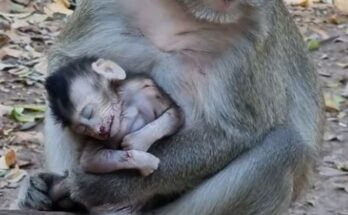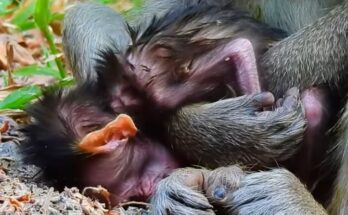In the heart of a lush jungle, a striking moment unfolds between a mother monkey and her infant, capturing a deeply emotional and instinct-driven scene: the baby monkey clings desperately to its mother as she attempts to wean it off milk feeding. This behavior, though seemingly harsh to human eyes, reflects a vital stage in primate development, where maternal instincts and natural survival strategies intersect.
The baby monkey, still small and vulnerable, wraps its limbs tightly around its mother’s belly, seeking the comfort and sustenance it has known since birth. Its tiny hands grip with surprising strength, its face pressed against her in stubborn defiance. Meanwhile, the mother, with a mixture of patience and firmness, tries to dislodge her young one. She gently pries the infant away, pushing it off her teat and nudging it toward solid food scattered on the forest floor. Her actions, far from cruel, are rooted in the instinct to teach her baby how to grow independent and adapt to life in the wild.
This moment is a crucial developmental milestone. In many primate species, including macaques and langurs, mothers begin weaning their offspring anywhere from a few months to over a year after birth, depending on the species and environmental conditions. The transition from milk to solid food is not just about diet—it is about learning social behaviors, developing motor skills, and understanding group dynamics. In the wild, survival depends on the ability to forage, avoid predators, and eventually take a place in the troop’s hierarchy.
Yet for the infant, this separation is often met with intense resistance. Milk feeding is not only a source of nutrition but also a profound source of comfort and bonding. The baby’s reluctance to let go reflects a deep emotional attachment, and the struggle can last for days or even weeks. Observers often describe the infant’s cries, physical attachment, and repeated attempts to nurse as heart-wrenching.
From the mother’s perspective, however, this is a natural and necessary step. Continued nursing places a physical burden on her and may interfere with future reproduction. By gradually encouraging her young to eat solid food and interact more with the environment, she ensures that it gains the skills and strength needed for independence.
Wildlife researchers often witness such scenes while studying primate behavior. They note the delicate balance that mothers must strike—nurturing and protecting their offspring while also preparing them for life without constant maternal care. In some cases, mothers may allow short, symbolic nursing sessions even after weaning has begun, a gesture that seems to soothe the baby while reinforcing boundaries.
In the wild, the process of weaning is a quiet drama, full of tension and tenderness. The image of a baby monkey clinging to its mother, unwilling to give up the comfort of milk, is a poignant reminder of the universal challenges of growing up—of learning to let go, to adapt, and to face the world on one’s own. Even in the jungle, love and independence walk hand in hand.
Would you like a photo or visual diagram to go with this story?


